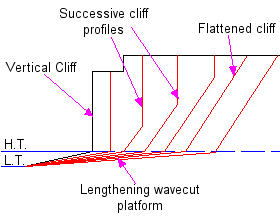Flattening of an active cliff in resistant rock.
Please start at Evolution.html
Conditions:
(a) Sea level is stable.
(b) Marine erosion takes place at the foot of the cliff between mean high tide and low tide level.
(c) The rock is mechanically strong enough to support a vertical slope.
(d) Physical weathering of the cliff is very rapid.
(e) Weathering detatches material from the cliff that falls as small debris to base of the cliff.
(f) Initially wave action is able to remove all the weathered material from the base of the slope but not undercut the cliff.
(g) When the cliff lengthens due to land rising away from the sea weathering produces more material than the sea can remove.
Explanation of the simulation:
(a) Solid rock is shown in green, weathered debris in brown and beach debris in yellow. The rock is divided up into squares to represent the fragments that it weathers to.
(b) Each click on the manual simulation represents a constant unit of time.
(c) When the cliff is 6 units high wave action can just remove all the weathered debris in a given unit of time.
(d) When the cliff is 7 units high wave action can only remove 6 units of weathered debris so 1 remains at the foot of the cliff.
(e) At each successive stage 6 units of weathered debris is always removed.
(f) This does not mean that the base of the cliff no longer retreats but that a gentler slope extends progressively upwards at the angle of rest of the weathered debris. In the simulation this is 45 degrees. The dimensions of the rectangles could be adjusted to give an angle of rest at any angle.
(g) While a vertical slope remains at the top of the cliff debris falls off it. However on the lower gentler slope a shallow layer of debris slides down to the sea as the basal fragment is removed by wave action.
(h) Eventually the entire cliff will be at the angle of rest of the weathered debris. Marine erosion is than back in control. It continues to remove 6 units of weathered debris in unit time, the cliff retreats at a constant angle and debris slide replaces rock fall as the dominant type of mass action.
(g) The rising height of the cliff slows the rate at which the base of the cliff retreats and leads to flattening of the cliff as shown in the diagram below:

Flattening of an active vertical cliff could also take place in the same way if the climate and rate and type of weathering changed. For example if the number of diurnal freeze-thaw cycles and frost action increased to produce more weathered debris for the sea to remove.
I have observed changes in cliff profile in line with my simulation along the N. Yorkshire coast between Saltburn and Skinningrove. Hunt cliff has a lower gentler slope at the angle of rest of weathered shales.
|
